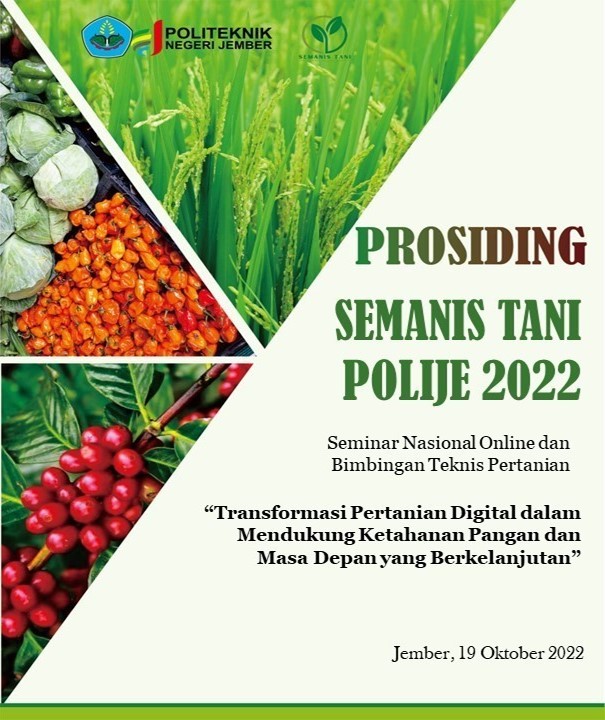Uji Daya Hasil dan Penampilan Galur Mutan Harapan Sorgum Manis di Citayam, Bogor
DOI:
https://doi.org/10.25047/agropross.2022.294Kata Kunci:
agronomy, mutant lines, Quality of Seeds, production, mutation breedingAbstrak
Sorghum (Sorghum bicolor (L) Moench) including cereals is also called a multipurpose plant because the seeds can be used as a food, industrial materials such as flour, starch. In addition, the stems and leaf can be used as ruminant animal feed and the stem biomass is squeezed to produce juice for the bioenergy raw material (bioethanol) and fresh drinks. However, sorghum is not originated from Indonesia, therefore, genetic diversity is limited. The efforts to improve and increase the genetic diversity are carried by mutation breeding. At the Center for Research and Technology Radiation Process (PRTPR), Nuclear Energy Research Organization (ORTN), National Research and Innovation Agency (BRIN). Research objective is to obtain mutants with superior characteristics of growth and yield, better than the original parent. Sweet sorghum plant breeding research using induced mutation technique using gamma rays sourced from Cobalt-60 to improve agronomic characteristics and quality. A number 9 promising mutant lines GH1, GH2, GH3, GH5, GH6, GH7, GH9, GH10 dan GH38, were included as 3 controls plant namely Cty-43 (parent), Samurai 1 and Numbu varieties (national control). Grown during drought season 2020 of BB-Balitbiogen located in Citayam, Bogor. Data measurements were callected for several agronomic characters including grain yield, analyzed by using ANOVA softwares SAS method versi 9.1. The results showed GH9 mutant line highest grains yield (9.87 t/ha), GH10 highest biomass production (64.83 t/ha) and GH1 the highest (12.53% brix) significantly higher than the 3 controls have yields 6.22, 7.22 and 7.89 t/ha grains, 41.36, 44.40 and 52.33 t/ha biomass and 8.96, 9.00 and 11.32 % brix sugar content.
Unduhan
Referensi
Arwin, H. Mulyana, Tarmizi, Masrizal, K. Faozi dan M. Adie (2012). Galur Mu-tan Kedelai Super Genjah Q-298 dan 4-Psj. J. Ilm. Apl. Isot. dan Radiasi, vol. 8, no. 2.
BATAN. (2022) Hasil Teknologi Litbang Iptek Nuklir Batan di Bidang Pertanian. http://www.batan.go.id/index.php/id/pelepasan-varietas-pair. (Di akses tanggal 14 Februari 2022).
House, LR. (1995). A Guide to Sorghum Breeding. International Crops Re-search Institute for semi-Arid Tropics. Andhra Pradesh, India.
Sihono, S. Human, W.M. Indriatama Carkum, Parno dan W. Puspita. (2014). Proposal Pelepasan Varietas “Galur Mutan Sorgum PATIR-1 Berdaya Hasil Biji, Biomassa dan Gula Batang Tinggi serta Galur Mu-tan PATIR-4 Hasil Biji Tinggi Kuali-tas Baik”. Jakarta.
Sihono (2017). Presentasi Ilmiah Peneliti Madya. Sorgum Galur Mutan Harapan PATIR-1 dan PATIR-4 Produksi Tinggi sebagai Sorgum Manis Varietas Samurai 1 dan Samurai 2. Pusat Aplikasi Isotop dan Radiasi BATAN. Jakarta.
Sungkono (2009) Seleksi Tanaman Sorgum (Sorghum bicolor L. Moench) Untuk Produktivitas Biji dan Bioetanol Tinggi pada Tanah Masam Melalui Pendekatan Participatory Plant Breeding. Proposal penelitian sebagai salah satu syarat dalam rangka penulisan Disertasi Doktor pada Program Studi Agronomi. Sekolah Pascasarjana, Institut Pertanian Bogor.
Roesmarkam, S, (1988). Stabilitas hasil Tinggi dan Umur Tanaman Galur-galur Harapan Sorgum. Kumpulan Kliping Sorgum. Pusat Informasi Pertanian Trubus. Jakarta.
Sobrizal (2016). Potensi Pemuliaan Mutasi untuk Perbaikan Varietas Padi Lokal Indonesia. J. Ilm. Apl. Isot. dan Ra-diasi, vol. 12, no. 1.
Human, S, Sihono dan Parno (2006). Perbaikan genetik sorgum melalui program pemuliaan tanaman. Maka-lah dalam Fukus Grup Diskusi “Prospek Sorgum untuk Mendukung Ketahanan Pangan dan Energi”. MENRISTEK-BATAN. Serpong.
Notohadiprawiro, T. (1996). Keselamatan sumber daya tanah dalam kebijakan ekonomi di Indonesia dalam Khairiyah, K., Ismunandar dan E, Handayanto. 1998. Pengelolaan tanah secara biologi pada lahan kering beriklim basah melalui pendekatan holistic dan spesifik lokasi menuju system pertanian berkelanjutan. Prosid. Seminar Nasional dan Pertemuan Tahunan KOMDA HITI. Jakarta.
University of Nebraska Lincoln, USA, Department of Agronomy & Horti-culture. (2013). Sweet sorghum is a drought-tolerant feedstock with the potential to produce more ethanol. http://agronomy.unl.edu/sweetsorghum (diakses 5 April 2022).
Unduhan
Diterbitkan
Cara Mengutip
Terbitan
Bagian
Lisensi
Hak Cipta (c) 2022 Sihono, Soeranto H, Wijaya M, Indriatama, Marina Y.M, Winda Puspitasari

Artikel ini berlisensi Creative Commons Attribution 4.0 International License.
Hak cipta (Copyright) artikel yang dipublikasikan di Agropross : National Conference Proceedings of Agriculture dipegang oleh penulis (Copyright by Authors) di bawah Creative Commons Attribution 4.0 International License (CC-BY). Sehingga penulis tidak memerlukan perjanjian pengalihan hak cipta yang harus diserahkan kepada redaksi.






